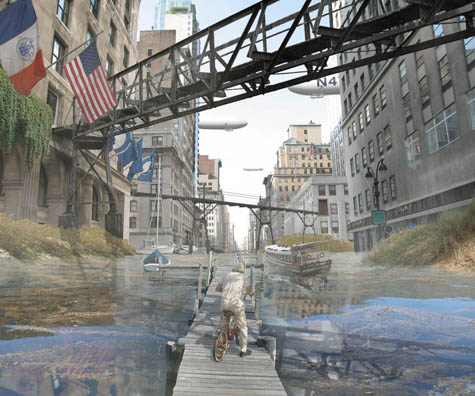 [Image: "Aqualta: 5th Avenue & 35th Street, NYC," by Studio Lindfors; view larger].
[Image: "Aqualta: 5th Avenue & 35th Street, NYC," by Studio Lindfors; view larger].Studio Lindfors—of Cloud Skippers and Cloud City fame—have released a stunning new series of images, published here on BLDGBLOG for the first time, in which we see New York City and Tokyo after a catastrophic flood.
 [Image: "Aqualta: Garment District, NYC," by Studio Lindfors; view larger].
[Image: "Aqualta: Garment District, NYC," by Studio Lindfors; view larger].Called Aqualta, the project is an exquisitely produced tour of a hydrologically transformed metropolis. Gondolas float through a still-blazing Times Square; people fish atop gravel banks that have built up beside inundated skyscrapers; and an aerial network of blimps, catwalks, pedestrian skyways, and cable cars passes and sways above the Venetian streets.
I can't emphasize enough how beautifully detailed the images are; I've put them into a Flickr set for closer viewing. They knock me out.

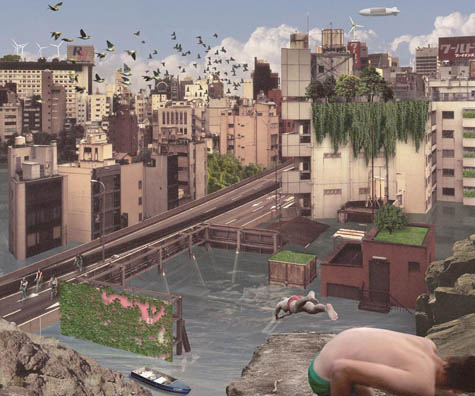
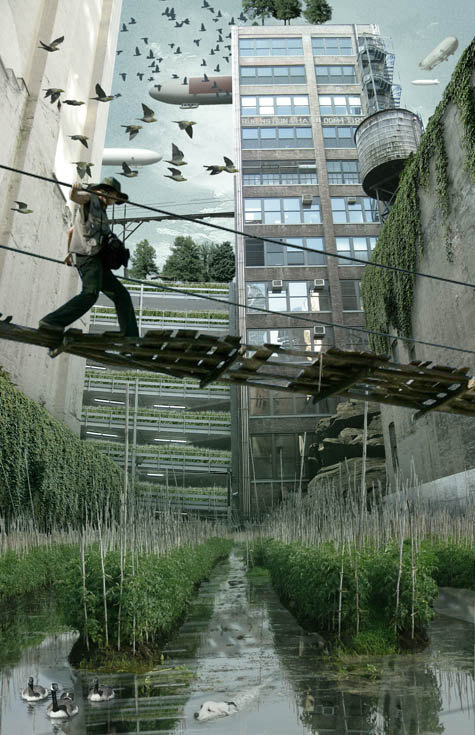 [Images: "Aqualta: Times Square at Night, NYC," "Aqualta: Roppongi Minato-ku, Tokyo," and "Aqualta: W. 29th Street & Broadway, NYC" by Studio Lindfors].
[Images: "Aqualta: Times Square at Night, NYC," "Aqualta: Roppongi Minato-ku, Tokyo," and "Aqualta: W. 29th Street & Broadway, NYC" by Studio Lindfors].Similar in spirit to Squint Opera's earlier look at a Flooded London, Aqualta is hard—if not impossible—to separate from the context of melting ice caps and global climate change. However, it deserves visual attention in its own right, even outside such politically charged discussions.
Far from stoking fear about a coming catastrophe, both of these projects—Studio Lindfors and Squint Opera—offer a vision in which people, and the cities they live in, have learned to adapt to the overwhelming presence of water. Indeed, Times Square, in Studio Lindfors's vision, is radiant, markedly improved by the reflective waters that now flow through it. Of course New York should be at least partially flooded, one might be tempted to think; of course the future of urban planning involves designing with water.
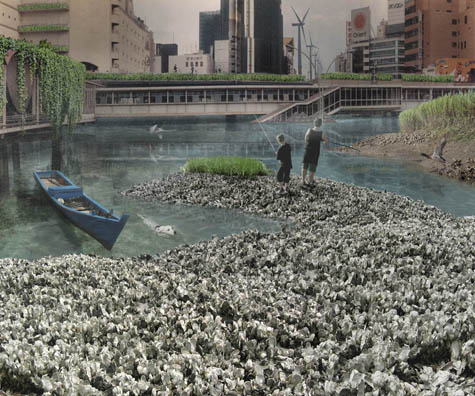 [Image: "Aqualta: Shibuya Station, Tokyo," by Studio Lindfors; view larger].
[Image: "Aqualta: Shibuya Station, Tokyo," by Studio Lindfors; view larger].In fact, there's a memorable, if brief, scene in Steven Baxter's recent novel Flood—a surprisingly thought-provoking book about a global flood that, in Wikipedia's words, "even covers Mount Everest in 2052, submerging all landmasses on Earth"—where we see a character scraping barnacles off the rocky sides of New York high-rises after the city has been lost to the sea. South Manhattan has been transformed into a tidal world of mussels, clams, and seaweed—and, even then, the waters continue to rise. But if that novel were ever to be adapted for film, I'd unhesitatingly suggest that Studio Lindfors's visual firepower be snapped up for art direction and set design.
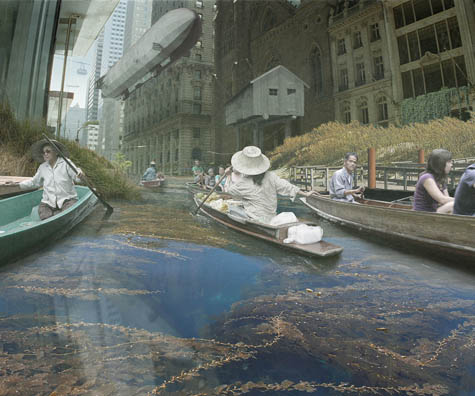 [Image: "Aqualta: 5th Avenue & 53rd Street, NYC," by Studio Lindfors; view larger].
[Image: "Aqualta: 5th Avenue & 53rd Street, NYC," by Studio Lindfors; view larger].The architects got in touch after reading the urban premise of DJ /rupture's new album with Matt Shadetek, mentioned a few days ago; in an interview with New York magazine, /rupture says the new mix "paints a picture of New York 40 years in the future, where the water line is at the fourth story of buildings and the rich people are dry in the Catskills. Kids are making music on their cell phones and grilling octopi. So, it’s postapocalyptic, but not necessarily grim."
Again, check out the images in more detail.
No comments:
Post a Comment